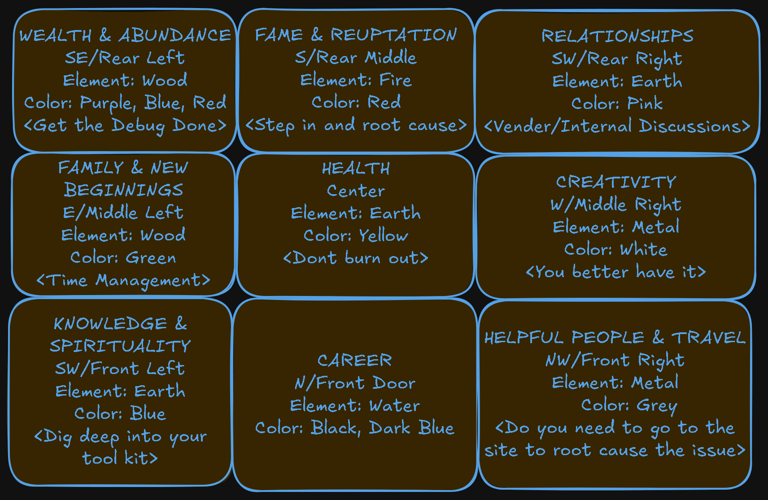

Balancing the Elements: Applying Feng Shui Principles to Debugging Compute Systems
Memory Matter #5
In the realm of computer engineering, debugging techniques have long been essential tools for unraveling the complexities of hardware and software systems. Yet, as technology advances, developers find themselves seeking innovative approaches to tackle increasingly intricate long pull issues. This article explores an unconventional perspective: the application of Feng Shui principles to debugging compute systems. By drawing parallels between the ancient Chinese practice and modern troubleshooting methods, we aim to shed new light on familiar challenges.
This exploration delves into the intersection of Eastern philosophy and Western technology, examining how concepts such as the Five Elements and Chi can be applied to system components and debug flow. Debugging is enjoyable for us select few and is stressful. Working with Feng Shui debug concepts helps lighten the activity. We'll investigate how traditional debugging approaches like divide and conquer, analyzing race conditions, and reviewing stack traces can be enhanced through a Feng Shui lens. Additionally, we'll discuss the potential benefits of this unique viewpoint in addressing common issues such as memory leaks and the value of techniques like rubber duck debugging and comprehensive logging with explicit data gathering in maintaining system harmony.
Understanding Feng Shui and Debugging Parallels
Core principles of Feng Shui
Feng Shui, an ancient Chinese practice, focuses on harmonizing individuals with their surrounding environment. At its core, Feng Shui is based on the concept of Chi, the vital life force or energy that flows through all things. The goal is to create a balanced and harmonious living space that promotes positive energy flow.
One of the fundamental principles of Feng Shui is the Bagua, an energy map that divides a space into eight areas, each corresponding to different aspects of life such as wealth, relationships, and career. By understanding and applying the Bagua, practitioners aim to enhance specific areas of their lives through thoughtful arrangement of their living spaces.
Another key concept in Feng Shui is the balance of the five elements: wood, fire, earth, metal, and water. These elements are believed to interact in cycles of generation and destruction, and their proper balance is essential for creating harmony in a space which allows for the proper flow of debug energy.
Fundamental aspects of compute debug
Debugging techniques are essential tools for unraveling the complexities of software systems. There are two distinct Debug Camps in the lab that consist of either the uber organized debugger or the rogue automotive shop type of debug engineer. Both are extremely efficient at getting the job done. Personally, having been involved in numerous high critical system based debugs, appreciate both camps as if one doesn't work then its mind opening to jump to the other. Commonly i try to start with the organized approach and when the debug takes longer than a week that process quickly gets left on the wagon. At its core, debugging involves identifying, isolating, and correcting problems or "bugs" in computer systems, either hardware or software. The process typically begins when a developer locates a hardware hang or code error and can reproduce it consistently. Ill leave it to you to argue whether SW bugs are harder/easier to debug than HW ones.
One fundamental aspect of debugging is the use of hardware or software breakpoints, which allow master debuggers to pause program execution at specific points in an attempt to examine register or stack variables, memory states, or firmware code fail location. This technique enables engineers to analyze the program's behavior step by step, helping to pinpoint the source of issue.
Another crucial element of debugging is the analysis of stack traces, which provide a snapshot of the program's execution state at the moment an error occurs. Stack traces help developers understand the sequence of function calls leading up to the error, making it easier to identify the root cause of the problem. These stack traces can be in the form of hardware debug registers or software flows and commonly are viewed using an in target developer tool suite.
Identifying the common ground
While Feng Shui and debugging techniques may seem unrelated at first glance, they share some interesting parallels. Both disciplines aim to create harmony and balance within their respective domains. Just as Feng Shui seeks to optimize the flow of energy in a space, best known debugging techniques strive to improve the flow of data and logic within a computer program. If the debugger can identify where the flow of data (or lack there of) stops then a more focused lens can take place on the area. This can be in the form of a DRAM bit-flip, power management hiccup, initialization specification violation, or 3rd party interfacing failure - each by which has its own evolving story.
Both fields also emphasize the importance of careful observation and analysis. In Feng Shui, practitioners must assess the layout and energy of a space before making adjustments. Similarly, in debugging, developers must carefully examine code and system behavior to identify the source of problems. Are you on the latest firmware patch, bios revision, internal code stepping, OS patch, etc all are common to initial engagement of a debug flow. What results from the findings determines next steps.
Furthermore, both Feng Shui and debugging involve a systematic approach to problem-solving. Feng Shui practitioners use tools like the Bagua map to guide their decisions, while debug engineers employ various learned debugging techniques such as divide and conquer to systematically isolate and address issues in their code.
Here's a fun approach to tackling debugging elements with a Bagua map:
Five Relational Elements of Systemic Feng Shui
The concept of the Five Elements in Feng Shui offers a unique perspective for understanding and debugging compute systems. By drawing parallels between these ancient principles and modern technology, we can gain insights into creating harmonious and efficient debugging of systems.
Wood: Data structures and algorithms
In Feng Shui, wood represents growth, flexibility, and creativity. This aligns with data structures and algorithms, which form the foundation of software development. Just as wood branches out, data structures like trees enable efficient organization and retrieval of information. Debugging techniques such as divide and conquer can be applied to these structures, breaking down complex problems into manageable components. Divide and conquer is a method that the debug should always follow to organize her session logically and know where to dive into the next challenge.
Fire: Processing units and computational logic
Fire symbolizes energy, intelligence, and transformation. This corresponds to processing units and computational logic. The CPU, acting as the "fire" of the system, generates heat and powers the entire operation. When debugging issues related to processing, examining the stack trace can provide valuable insights into the execution flow and identify potential bottlenecks or race conditions. Heat transfer both in and out can cause timings to adjust potentially affecting root cause. Depending on how quirky you are, this can also translate to power and thermal density related to keeping the cube stacks cool, etc.
Earth: Storage and memory systems
Earth represents stability and grounding. This corresponds to storage and memory systems that form a robust basis for data storage and retrieval. Debugging memory-related issues, such as memory leaks, requires a thorough understanding of how data is stored and accessed within the system. Memory based bit errors can be extremely difficult to quickly understand and contain. Historically, nobody worries about memory execution until units have problems and then suddenly it is the hottest topic in executive meetings.
Metal: Hardware components and infrastructure
Metal embodies strength, conductivity, and structure. This element corresponds to the physical hardware components and infrastructure of computer systems. When debugging hardware-related issues, a systematic approach involving code review and hardware diagnostics is essential to identify and resolve problems effectively. Ensure that the hardware components which employ firmware are updated and on the latest version to grab that low handing fruit. A good amount of debugs are resolved by updating the software and firmware stacks.
Water: Network and communication protocols
Water symbolizes flow, adaptability, and communication. This aligns with network and communication protocols that facilitate data transmission between systems. High speed ethernet and other communication protocols transferring large amounts of data and failing randomly after hours/days can be a challenge to root cause. System fabrics are the key to the feeding of the compute pipe. Debugging computer related issues often involves analyzing logs and implementing robust logging mechanisms to trace the flow of data and identify potential communication bottlenecks. Logs can help outline what bit error rate you are hitting, memory addressing fails and link drops.
Balancing Chi in Code and Hardware
Identifying energy blockages in system architecture
In the realm of debugging techniques, identifying energy blockages in system architecture is crucial for optimizing performance. Just as Feng Shui emphasizes the flow of Chi, developers must focus on the flow of data and logic within computer programs. By analyzing stack traces and employing divide and conquer strategies, programmers can pinpoint bottlenecks that impede the smooth operation of software systems. Energy blockages can also uncover hidden performance advantages if you look in the right location.
Techniques for improving code flow and efficiency
Once the fail type can be reproduced, next level methods must be employed. To enhance code flow and efficiency, developers can implement various debugging techniques. Profiling and benchmarking tools help identify performance bottlenecks, allowing for targeted optimizations. Minimizing nested loops, adding dummy debug variables and, along with reducing unnecessary variable declarations, can significantly improve execution speed [1]. Additionally, caching frequently used data or computational results can reduce redundant calculations and enhance overall performance [2].
Optimizing hardware layout for better performance
Optimizing hardware layout is essential for achieving better performance. Just as Feng Shui practitioners arrange spaces to facilitate energy flow, system designers must carefully consider component placement. Upgrading the air flow to the system may allow to understand fail cases that are thermal related. Learning how to speed up systems albeit, abnormally, also may provide a path to understand and hit the fail case faster. Furthermore, changing RAM DIMM types for other various configurations can help alleviate confusion, particularly for memory-intensive fails that are hard to understand (common case).
By applying these principles, developers can create more harmonious and efficient computing systems, balancing the flow of energy throughout both software and hardware components while applying positive energy to fulfilling the root cause output.
Conclusion
The fusion of Feng Shui principles with debugging techniques offers a fresh perspective on tackling complex issues in compute systems. We are taught early on that solving complex problems require them to be broken down to a series of smaller ones. By viewing system components through the lens of the Five Elements and applying concepts like Chi to code flow, developers can gain new insights to complete the debug of systems - and maybe have some fun with it. This approach encourages a holistic view of debugging, considering not just individual elements but their interactions and overall balance within the system.
As we've seen, this unconventional method has the potential to enhance traditional debugging approaches and address common issues in innovative ways. The goal of debug is to reproduce the failure fast and understand next step mitigations to close the issue. It highlights the importance of maintaining balance and promoting smooth energy flow in both software and hardware components. How do you organize your debug flows? Do you keep a log of experiments run? Are you managing your stress effectively? By incorporating these and your own best known principles, developers may find new paths to optimize performance, resolve stubborn bugs, and create more resilient systems that can adapt to changing demands and environments of today.
References
[1] https://softwareengineering.stackexchange.com/questions/7347/what-simple-techniques-do-you-use-to-improve-performance
[2] https://dev.to/akashakki/10-tips-for-optimizing-your-code-efficiency-21ol [3] https://www.kingston.com/en/blog/pc-performance/how-to-optimize-pc
Linked to ObjectiveMind.ai for increased content distribution.


